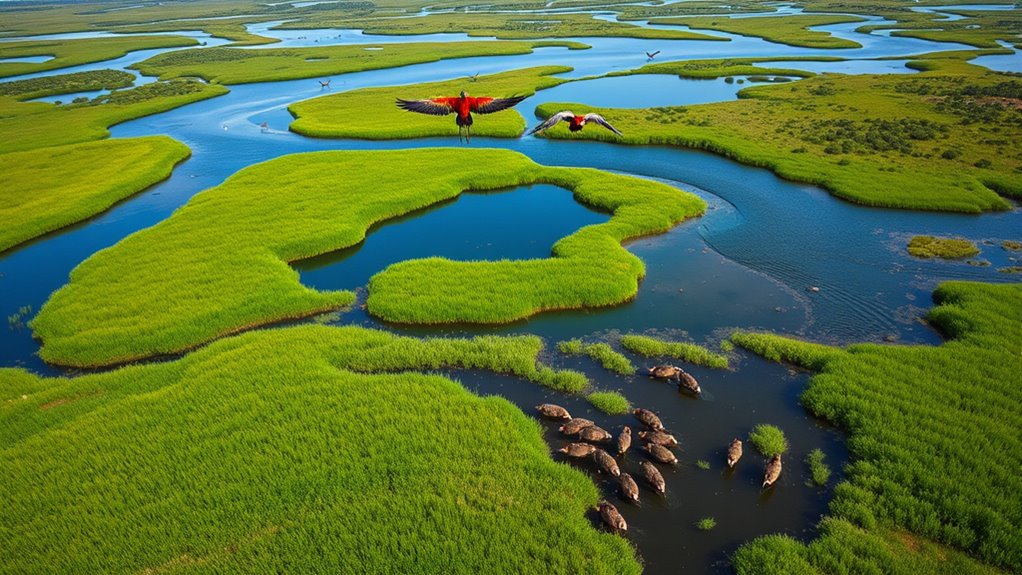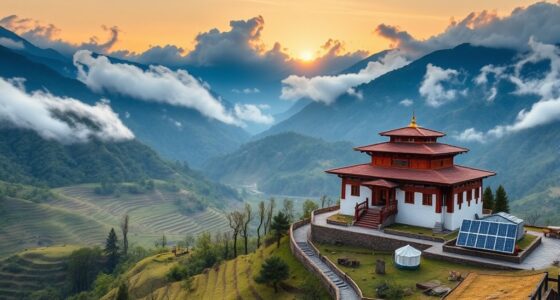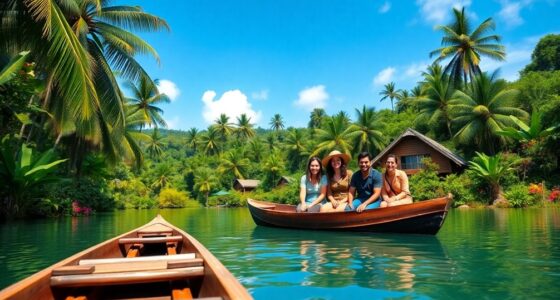Argentina’s Iberá Wetlands have seen remarkable recovery thanks to effective conservation efforts that involve community participation, sustainable tourism, and restoration techniques like native reforestation and invasive species control. These initiatives have revived water quality, expanded habitats, and boosted biodiversity. By balancing ecological health with cultural preservation, Iberá now serves as a global model for wetland restoration success. Exploring further reveals how this project continues to inspire sustainable environmental solutions worldwide.
Key Takeaways
- Comprehensive restoration efforts reintroduced native species and controlled invasive plants, improving biodiversity and ecosystem health in Iberá Wetlands.
- Community engagement and eco-tourism initiatives generated sustainable economic benefits, supporting conservation funding and local livelihoods.
- Adaptive management and regular monitoring of water quality and habitat conditions have ensured ongoing restoration success.
- Collaboration among government, scientists, and local communities strengthened conservation strategies and cultural preservation.
- Iberá Wetlands now serve as a global model for successful ecosystem restoration and biodiversity recovery.
The Historical State of the Iberá Wetlands

The Iberá Wetlands once thrived as one of South America’s most extensive and pristine freshwater ecosystems. At its peak, the wetlands showcased remarkable flora diversity, supporting countless plant species that sustained a vibrant food chain. Water quality was high, maintaining clear waters that nurtured abundant aquatic life. You could see lush reeds, floating mats, and dense forests along the shores, reflecting the healthy environment. The wetlands’ natural balance allowed for thriving populations of fish, birds, and other wildlife, making it a crucial ecological hub. Over time, human activity and environmental pressures began degrading water quality and reducing flora diversity, threatening this delicate ecosystem. Recognizing its past richness helps you understand the importance of ongoing restoration efforts to revive its former vitality. Additionally, embracing innovative conservation strategies, such as digital platforms for collaboration, can play a significant role in restoration projects.
Key Threats and Challenges Faced by the Ecosystem
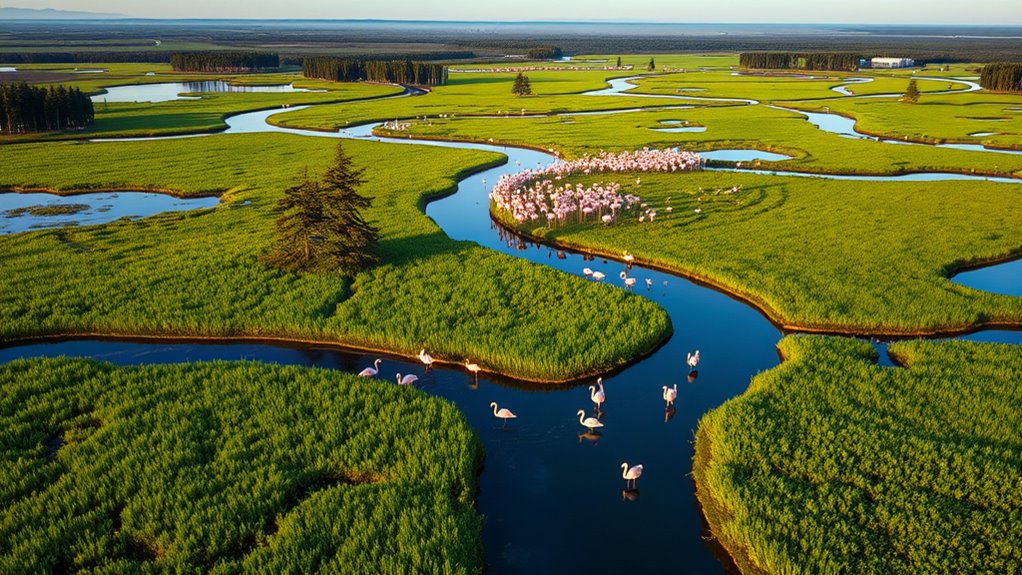
Human activities have considerably intensified threats to the Iberá Wetlands, disrupting its delicate balance. Pollution challenges, like agricultural runoff and waste disposal, threaten water quality and habitat health. Invasive species, such as feral pigs and certain plants, compete with native wildlife and degrade ecosystems. These pressures weaken the wetlands’ resilience and hinder recovery efforts. Understanding the threats is vital to safeguarding this creative practice environment.
Initiatives Driving Wetlands Revival
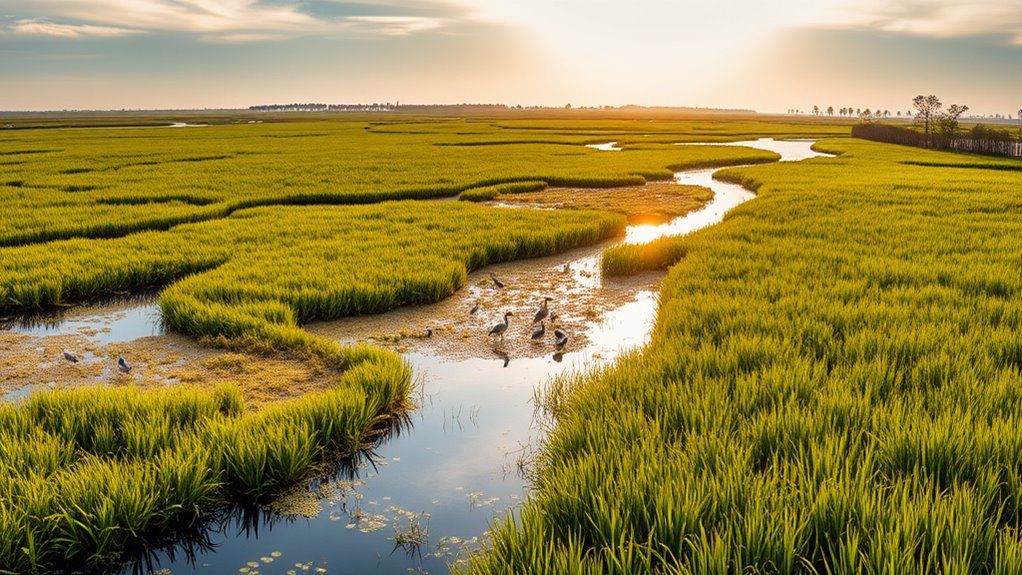
You can see how community engagement efforts are fueling real change, bringing local people into the restoration process. Conservation policy improvements are creating stronger legal frameworks to protect essential habitats. Additionally, sustainable tourism initiatives are balancing economic growth with the wetlands’ long-term health. Implementing investment strategies in precious metals can further support the financial stability of communities involved in conservation efforts.
Community Engagement Efforts
Community engagement plays a crucial role in driving the wetlands revival in the Iberá region. Your involvement helps preserve indigenous traditions and encourages local participation, ensuring the project’s success. Here are four key efforts making a difference:
- Educational programs that teach residents about wetlands’ importance and indigenous practices.
- Community-led monitoring, where locals track water quality and wildlife health.
- Cultural events celebrating indigenous traditions, strengthening community bonds.
- Partnerships with local leaders who champion conservation and sustain engagement.
- Incorporating mental health support into community activities promotes overall well-being and resilience, further strengthening conservation efforts.
Conservation Policy Improvements
How can policy changes accelerate the recovery of the Iberá wetlands? By implementing targeted policy reforms, you can streamline protection efforts, establish stronger legal frameworks, and prioritize conservation. These reforms help reduce threats like deforestation and illegal land use, creating a safer environment for wildlife and ecosystems. Additionally, improving funding strategies ensures sustainable financial support for restoration projects, research, and enforcement. You can advocate for increased government allocations, public-private partnerships, and innovative funding mechanisms that maximize resources. When policies are clear and well-funded, they create a solid foundation for long-term wetlands revival. Effective policy enforcement and coordinated efforts drive meaningful change, making it easier to protect and restore the Iberá wetlands for future generations.
Sustainable Tourism Initiatives
Sustainable tourism initiatives play an essential role in driving the revival of the Iberá wetlands by balancing environmental preservation with economic development. These efforts focus on eco tourism development that minimizes ecological impact while offering authentic experiences. You can explore local wildlife, supporting conservation efforts firsthand. Additionally, cultural heritage preservation ensures that local traditions and history remain intact, enriching visitor experiences. Here are four key initiatives:
- Eco-friendly lodges and guided tours that protect natural habitats
- Community-led tourism programs supporting local artisans and traditions
- Educational centers promoting awareness about wetlands’ ecological importance
- Responsible wildlife watching to prevent disturbance and promote conservation
Integrating innovative technology can further enhance visitor engagement while maintaining ecological integrity.
Role of Community Engagement in Conservation Efforts
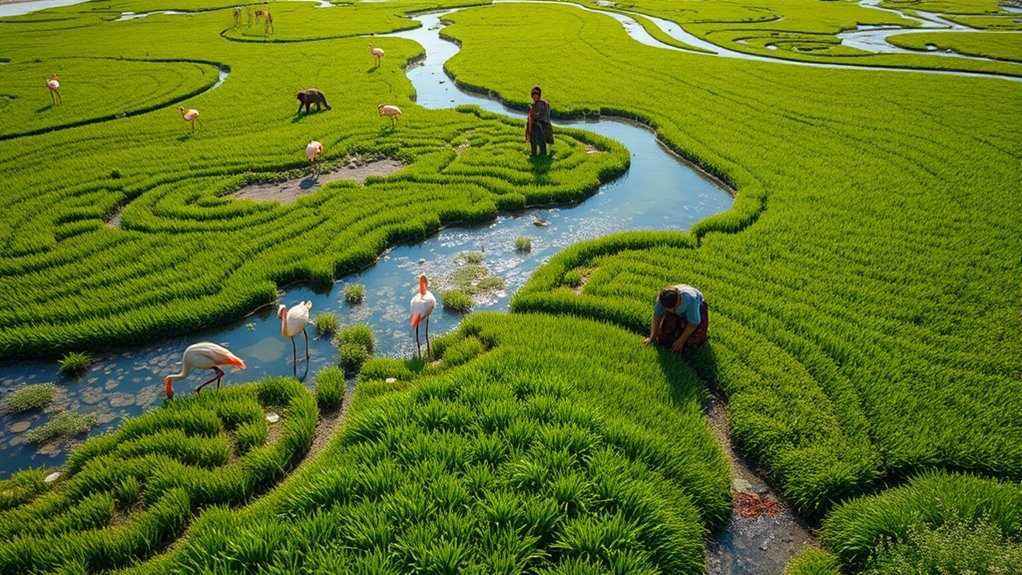
Engaging local residents plays a crucial role in the success of conservation efforts in the Iberá Wetlands. When you involve the community, you foster a sense of ownership and responsibility, which boosts community participation and sustains conservation initiatives. Empowering locals ensures they understand their essential role in protecting the wetlands, leading to more effective preservation. To deepen your understanding, consider this table:
| Aspect | Impact |
|---|---|
| Community participation | Increased local investment in projects |
| Local empowerment | Long-term sustainable conservation |
| Education & awareness | Greater ecological understanding |
A thorough understanding of color accuracy and its impact can help tailor conservation messaging to resonate more effectively with local communities.
Restoration Techniques and Environmental Strategies
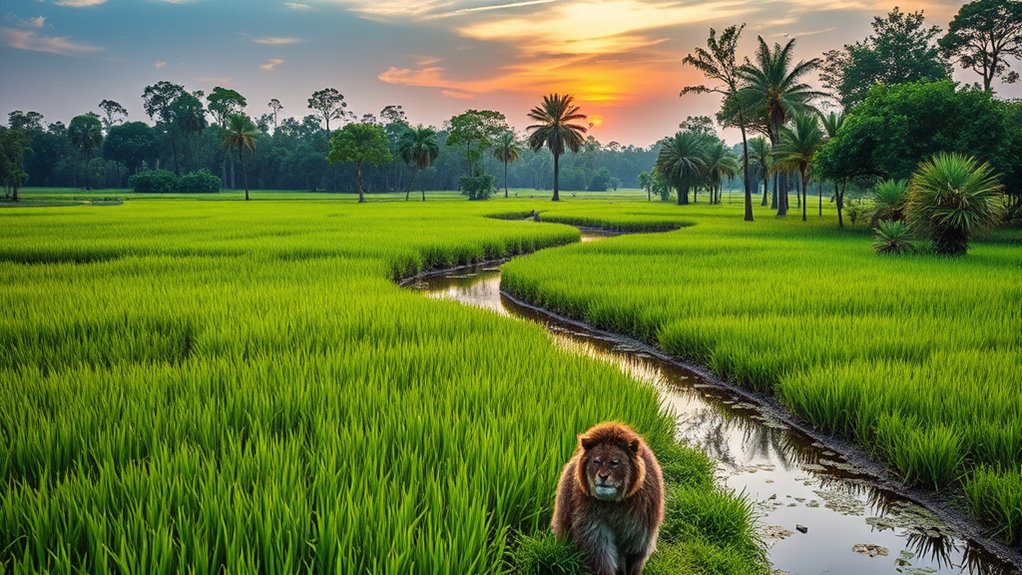
You can help restore the Iberá Wetlands by focusing on reintroducing native species that are crucial to the ecosystem’s balance. Implementing sustainable habitat management ensures these habitats remain healthy and resilient over time. Together, these techniques strengthen the wetlands’ natural capacity to recover and thrive, especially when incorporating effective conservation strategies that support long-term ecological health.
Native Species Reintroduction
How can we effectively reintroduce native species to restore the Iberá Wetlands? First, you must identify key species that once thrived here, ensuring they suit current environmental conditions. Second, control invasive species that compete with native flora and fauna, helping improve water quality and ecosystem balance. Third, implement targeted reintroduction programs, monitoring their adaptation and survival rates carefully. Fourth, engage local communities to support conservation efforts, reducing human impact. These steps help restore biodiversity and ecosystem health while addressing challenges like invasive species that threaten water quality. Reintroducing native species is essential for the wetlands’ resilience, ensuring a balanced environment that supports life and sustains the region’s ecological integrity. Additionally, fostering biodiversity hotspots can further enhance ecological resilience and promote species survival.
Sustainable Habitat Management
Implementing sustainable habitat management in the Iberá Wetlands requires employing effective restoration techniques and environmental strategies that support long-term ecological health. You focus on maintaining the wetlands ecosystem’s natural processes, guaranteeing that water flow, vegetation, and wildlife remain balanced. Habitat preservation involves restoring native plant communities and controlling invasive species, which helps sustain biodiversity. You might use controlled burns, reforestation, or water management systems to prevent erosion and enhance habitat quality. Additionally, regular assessment and adaptive management are vital to respond to changing environmental conditions and ensure the success of restoration efforts. By actively managing these elements, you support the resilience of the wetlands ecosystem for future generations. Sustainable practices prevent degradation, promote ecological stability, and guarantee that the wetlands continue to provide vital services, such as carbon storage and water filtration. Your efforts are essential for preserving Iberá’s unique environment.
Impact on Local Biodiversity and Wildlife

The restoration of the Iberá Wetlands has considerably boosted local biodiversity by creating a more hospitable environment for a variety of species. You’ll notice an increase in bird migration, as many species now find essential stopover points. Fish spawning has improved due to healthier water quality and expanded breeding grounds. This transformation also benefits mammals like capybaras and howler monkeys, which thrive in the restored habitats. Here are four key impacts:
- Enhanced bird migration routes and diversity
- Increased fish spawning success and population numbers
- Greater habitat availability for native mammals
- Greater resilience of local ecosystems to environmental changes
Together, these changes foster a richer, more balanced ecosystem that supports both wildlife and ecological health.
Sustainable Tourism and Economic Benefits
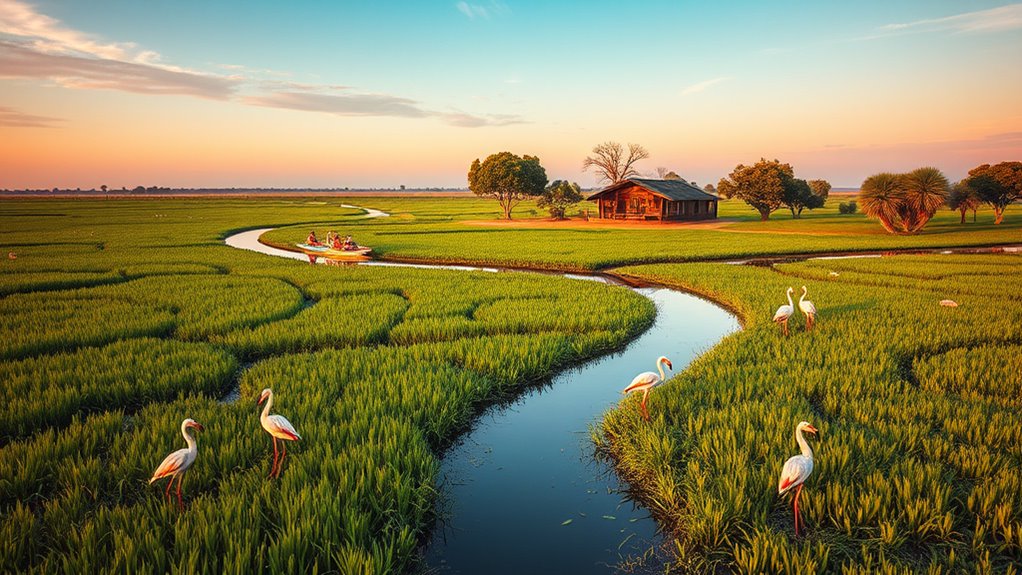
Restoring the Iberá Wetlands not only benefits local wildlife but also opens up new opportunities for sustainable tourism that can drive economic growth. You can now enjoy eco-friendly accommodations that minimize environmental impact while immersing yourself in the wetlands’ natural beauty. This sustainable approach attracts eco-conscious travelers enthusiastic to experience authentic wildlife encounters. Wildlife photography becomes a rewarding activity, as you capture images of rare species in their protected habitats. By supporting local businesses and conservation efforts, you contribute directly to the region’s economic development. The increase in responsible tourism creates jobs and promotes community engagement, ensuring the wetlands’ preservation for future generations. This blend of conservation and tourism offers a sustainable path forward, benefiting both ecology and local livelihoods.
Monitoring and Measuring Restoration Success
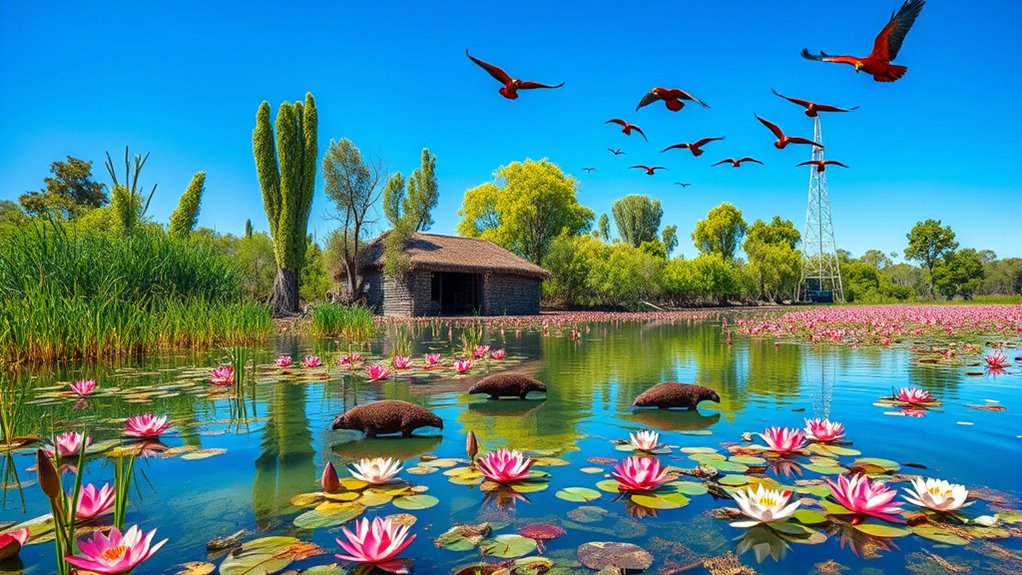
Monitoring and measuring the success of the Iberá Wetlands restoration requires clear, targeted strategies that track ecological changes over time. You focus on key indicators like wetland hydrology, ensuring water levels are stable and support native species. You also observe ecosystem connectivity, checking how well habitats link and function together. To do this effectively, consider these four approaches:
Track wetland water levels, species health, habitat links, and landscape changes to gauge restoration success.
- Regular water level assessments to monitor wetland hydrology
- Tracking species diversity and population health
- Mapping habitat connectivity and movement corridors
- Using remote sensing to observe landscape changes over time
Lessons Learned and Future Conservation Goals

Building on the strategies used to track ecological changes, reflecting on lessons learned during the Iberá Wetlands restoration helps identify what’s worked and where improvements are needed. You realize that integrating local communities’ cultural heritage has fostered stronger support and sustainable practices. Prioritizing water quality improvements proved essential for restoring habitats and maintaining biodiversity. However, future goals should include more targeted efforts to involve indigenous groups and preserve cultural sites, ensuring conservation respects local history. Ongoing monitoring reveals that balancing ecological health with cultural preservation enhances project success. Moving forward, you aim to strengthen collaboration, improve water management techniques, and embed cultural heritage into every stage of restoration. These lessons will guide you toward creating a more resilient, inclusive, and sustainable Iberá Wetlands.
The Iberá Wetlands as a Global Conservation Model
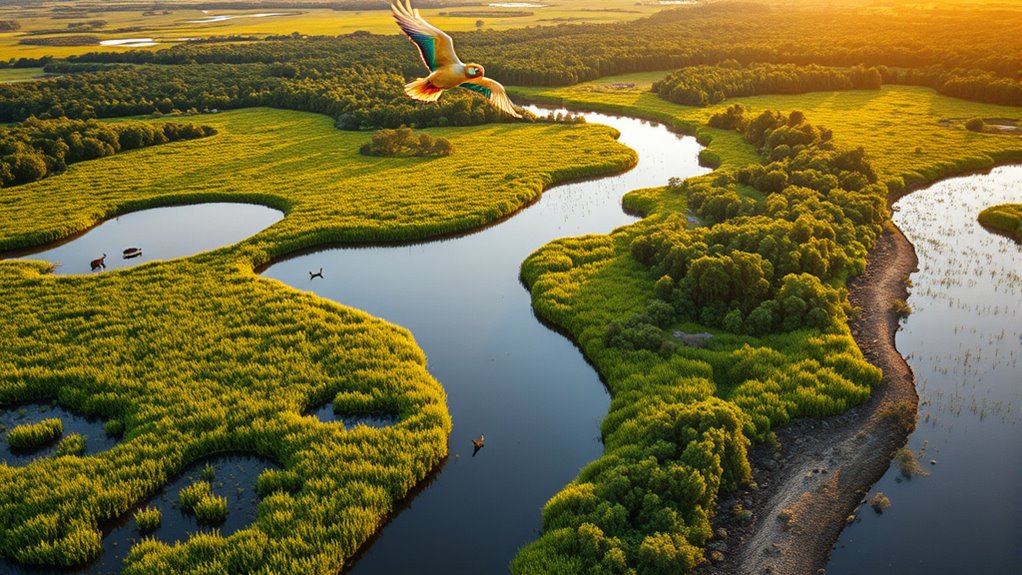
The Iberá Wetlands have emerged as a pioneering model for global conservation efforts due to their innovative approach to ecosystem restoration and community engagement. They demonstrate how restoring wetlands functions can boost biodiversity, improve water quality, and support local livelihoods. This success highlights the importance of ecosystem resilience, showing how healthy wetlands can recover from disturbances and adapt to climate change.
Consider these key aspects:
Focus on integrating science, community, water restoration, and eco-tourism to sustain wetlands worldwide.
- Integrating scientific research with community participation
- Restoring natural water flow and wetland functions
- Promoting sustainable ecotourism to fund conservation
- Serving as a blueprint for similar projects worldwide
Your role in supporting such efforts helps maintain these crucial ecosystems, ensuring their resilience for future generations.
Frequently Asked Questions
How Do Restoration Efforts Affect Indigenous Communities Nearby?
Restoration efforts can considerably impact indigenous communities nearby, especially regarding indigenous land rights. When communities are actively engaged in the process, they gain a voice in decision-making, ensuring their traditions and territories are respected. Community engagement fosters trust and collaboration, leading to sustainable outcomes. However, if ignored, these efforts risk marginalizing indigenous groups, potentially causing conflicts and loss of cultural heritage. Prioritizing their involvement promotes equitable and respectful restoration projects.
What Funding Sources Support Iberá Wetlands’ Ongoing Conservation?
You can see that the Iberá Wetlands’ ongoing conservation relies on diverse funding partnerships and international grants. These sources provide essential financial support, enabling continuous restoration and protection efforts. By collaborating with governments, NGOs, and global organizations, the project secures resources needed for ecological preservation. This network of funding guarantees the wetlands stay resilient, benefiting both the environment and local communities, and demonstrates the power of international cooperation in conservation.
Are There Any Unique Species Exclusive to the Iberá Wetlands?
You’ll find that the Iberá Wetlands host several unique species, many of which are endangered. These species thrive because of the habitat diversity in the wetlands, providing crucial ecosystems that support their survival. Some animals, like the marsh deer and the Yacare caiman, are exclusive to this region. Protecting this habitat guarantees these endangered species continue to thrive and highlights the importance of conserving such unique ecological environments.
How Does Climate Change Influence Future Restoration Plans?
You should consider how climate change impacts future restoration plans by focusing on climate adaptation strategies and enhancing carbon sequestration. As temperatures rise and weather patterns shift, restoration efforts must prioritize resilient species and habitats. By promoting natural carbon sinks like wetlands, you can help mitigate climate effects. Planning for these changes guarantees the wetlands remain healthy and productive, safeguarding biodiversity and ecosystem services for the future.
What Challenges Remain Despite Successful Ecosystem Recovery?
Like a fragile thread holding a tapestry, your ecosystem faces ongoing challenges. Despite progress, water quality remains vulnerable, threatened by pollution and runoff. Invasive species act like unwelcome guests, disrupting the native harmony and outcompeting local flora and fauna. These hurdles remind you that restoration isn’t a finish line but a continuous journey, requiring vigilance and adaptive strategies to safeguard the wetlands’ delicate balance for future generations.
Conclusion
You’ve seen how the Iberá Wetlands have risen from the ashes like a phoenix, proving that dedicated efforts can breathe new life into endangered ecosystems. By working together, you can be part of this inspiring story, ensuring these wetlands thrive for generations to come. Remember, conservation is a journey, not a destination—each step you take helps turn the tide toward a healthier, more vibrant future for our planet’s precious wetlands.

